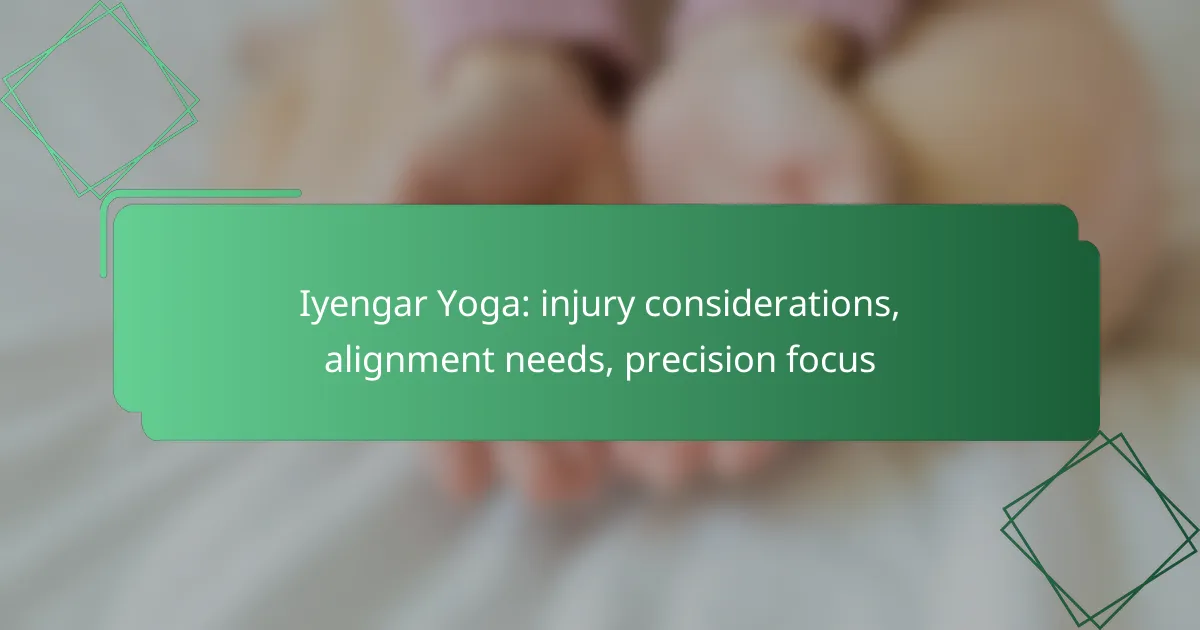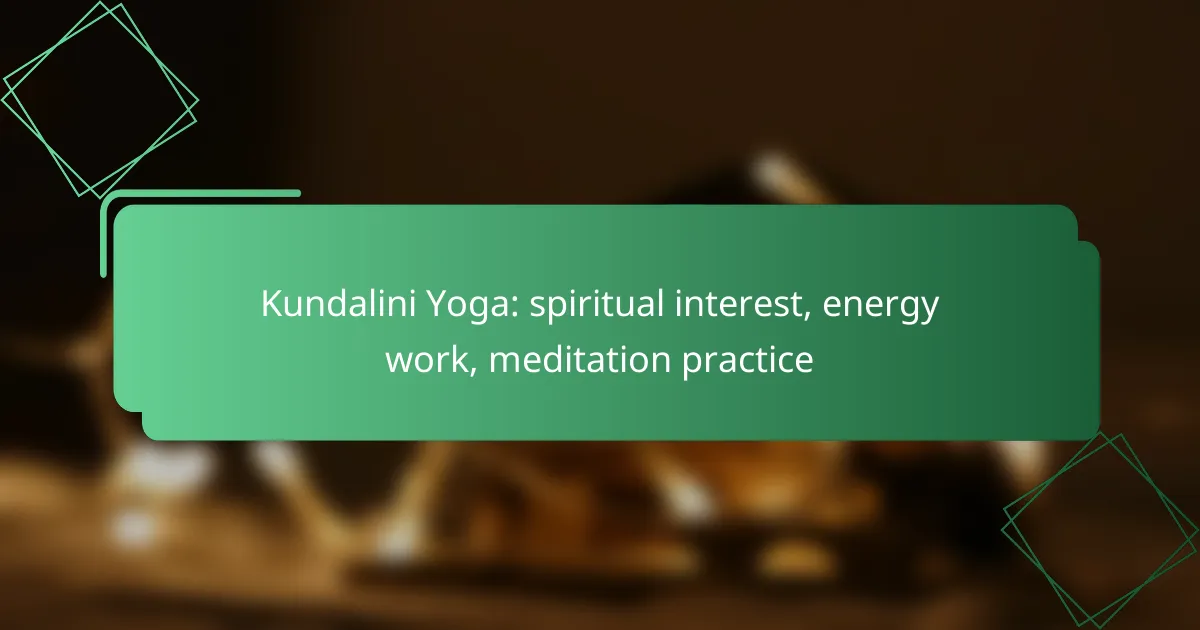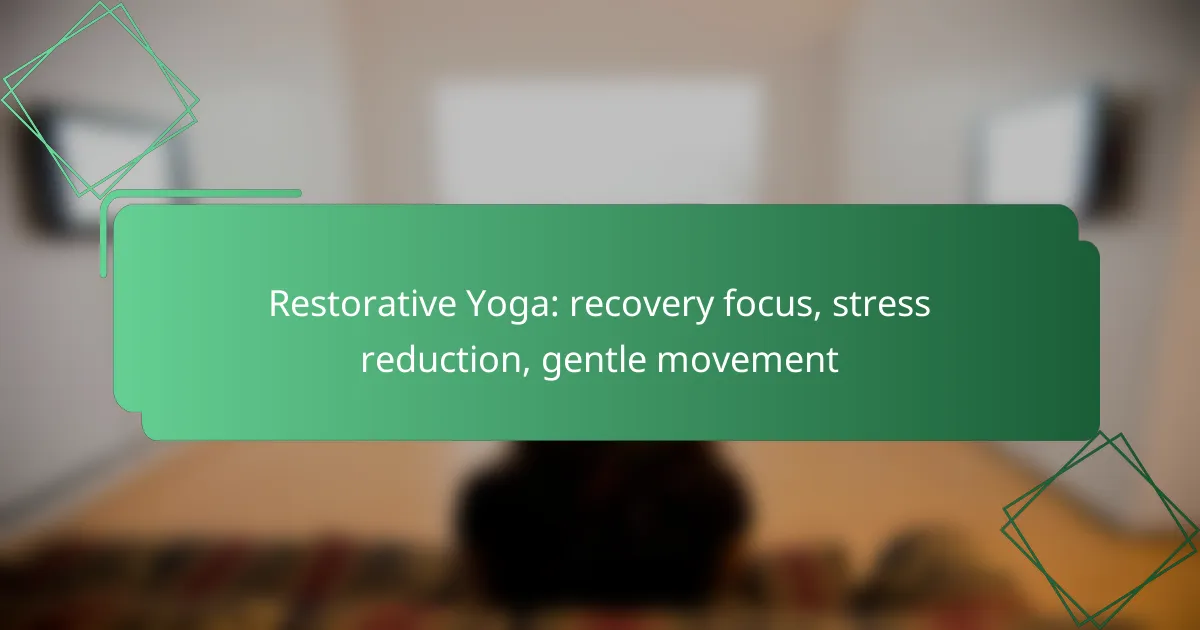Iyengar Yoga places a strong emphasis on injury considerations, urging practitioners to understand their physical limitations and the significance of proper alignment. By focusing on precise execution of postures, this practice not only enhances the effectiveness of each pose but also minimizes the risk of injury, encouraging a deeper awareness of body mechanics and individual capabilities.
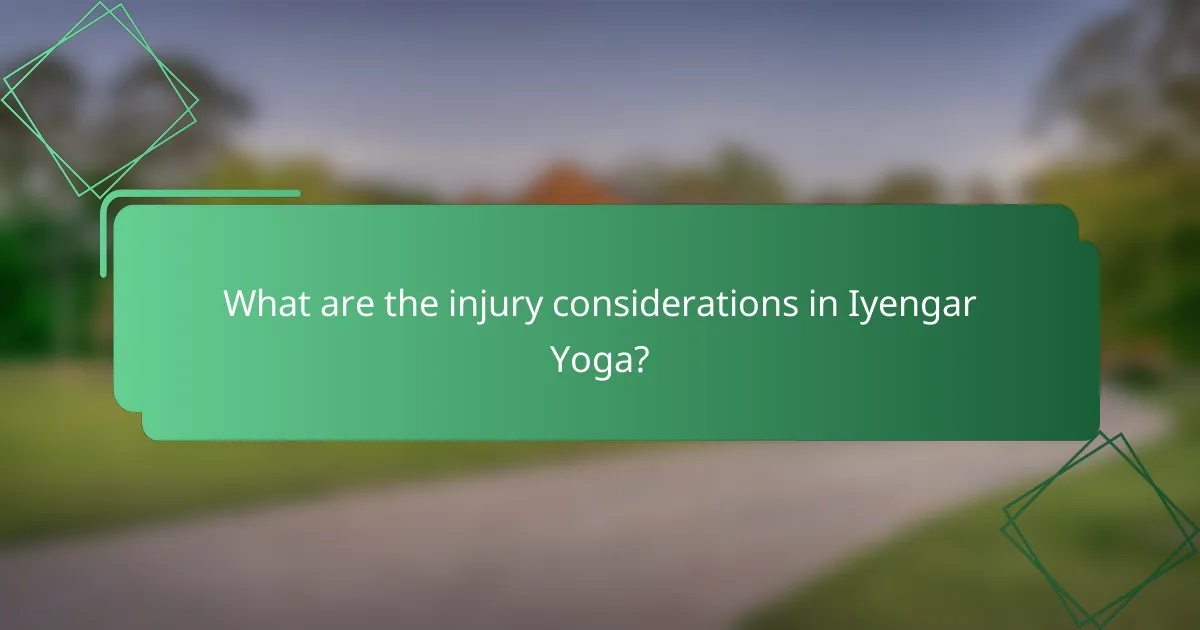
What are the injury considerations in Iyengar Yoga?
Injury considerations in Iyengar Yoga focus on understanding the physical demands of the practice and how to mitigate risks. Practitioners should be aware of their limitations and the importance of proper alignment to prevent injuries.
Common injuries in Iyengar Yoga
Common injuries in Iyengar Yoga often stem from improper alignment or overexertion. These can include strains in the lower back, shoulders, and knees, as well as wrist injuries from weight-bearing poses. New practitioners may be particularly susceptible to these injuries if they rush into advanced poses without adequate preparation.
Injuries may also occur when students push beyond their flexibility limits, leading to muscle tears or joint issues. Awareness of one’s body and its signals is crucial to avoid these common pitfalls.
Preventative measures for injuries
Preventative measures for injuries in Iyengar Yoga include practicing with mindfulness and focusing on alignment. It’s essential to listen to your body and modify poses as needed, especially when experiencing discomfort. Engaging in regular warm-ups can also help prepare the body for more challenging postures.
Additionally, working with a qualified instructor can provide personalized guidance on technique and alignment, reducing the risk of injury. Practitioners should also consider their physical condition and avoid pushing themselves too hard.
Role of props in injury prevention
Props play a significant role in injury prevention in Iyengar Yoga by providing support and enhancing alignment. Using blocks, straps, and blankets can help practitioners achieve proper positioning without straining their bodies. For instance, blocks can assist in reaching the ground in standing poses, while straps can aid in stretching without overextending.
Incorporating props allows for a more accessible practice, especially for beginners or those with previous injuries. They can facilitate deeper stretches and help maintain stability, ultimately contributing to a safer yoga experience.
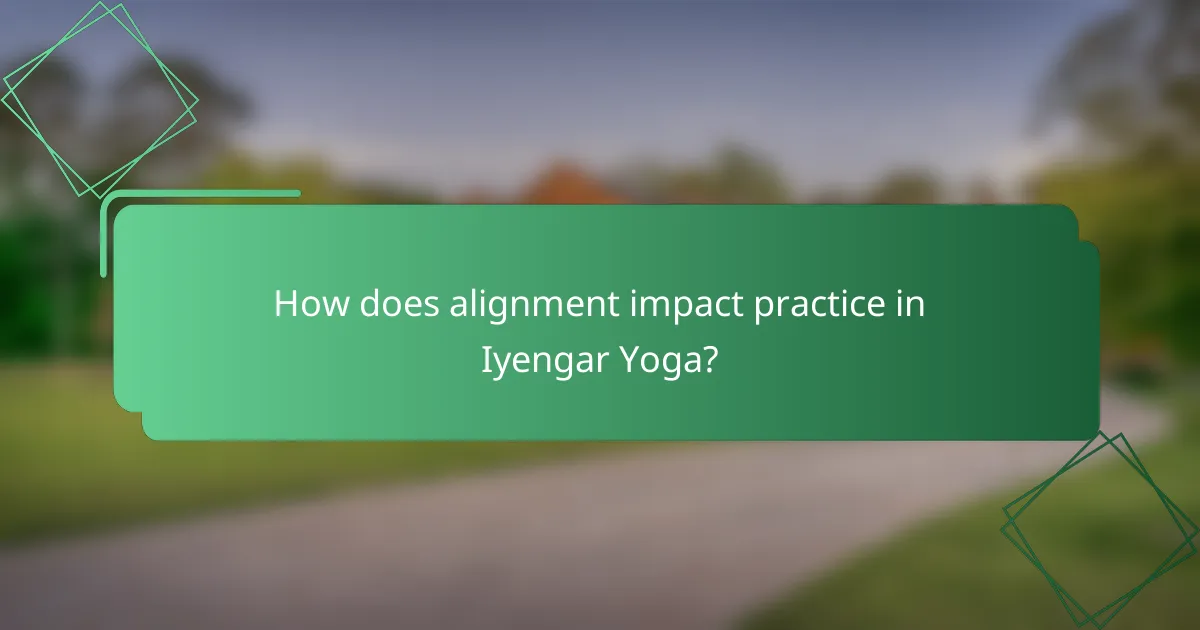
How does alignment impact practice in Iyengar Yoga?
Alignment is crucial in Iyengar Yoga as it enhances the effectiveness of poses and minimizes the risk of injury. Proper alignment ensures that the body is correctly positioned, allowing for optimal muscle engagement and balance during practice.
Importance of alignment in poses
Alignment in poses is essential for achieving the intended benefits of each posture. It helps maintain stability and balance, which are vital for both beginners and advanced practitioners. By focusing on alignment, practitioners can deepen their stretches and improve their overall strength.
Good alignment also facilitates better breathing and energy flow throughout the body, enhancing the meditative aspects of yoga. This focus on precision allows students to cultivate a greater awareness of their bodies and movements.
Common alignment issues
Many practitioners encounter alignment issues that can lead to discomfort or injury. Common problems include misaligned knees in standing poses, improper spinal curvature, and shoulder tension. These issues often arise from a lack of body awareness or insufficient strength in supporting muscles.
For instance, allowing the knees to extend beyond the toes in lunges can strain the joints. Similarly, rounding the back in forward bends can lead to lower back pain. Recognizing these misalignments is the first step toward correcting them.
Techniques for improving alignment
To enhance alignment, practitioners can utilize several techniques. First, using props such as blocks, straps, and blankets can provide support and guidance in achieving correct positioning. For example, a block can help maintain proper height in standing poses.
Additionally, practicing in front of a mirror allows for real-time feedback on alignment. Instructors can also offer hands-on adjustments to help students feel the correct alignment in their bodies. Regularly revisiting foundational poses can reinforce alignment principles and build strength over time.

What is the focus on precision in Iyengar Yoga?
The focus on precision in Iyengar Yoga emphasizes the correct alignment and execution of postures to enhance the effectiveness of the practice while minimizing the risk of injury. This approach encourages practitioners to pay close attention to their body mechanics and the subtleties of each pose, fostering a deeper understanding of their physical capabilities and limitations.
Benefits of precision in practice
Precision in Iyengar Yoga leads to improved physical alignment, which can enhance overall strength and flexibility. By practicing with attention to detail, students often experience greater stability in poses, allowing for longer holds and deeper engagement of muscles.
Additionally, a precise practice can help individuals develop better body awareness, which translates to improved performance in daily activities and other forms of exercise. This heightened awareness can also lead to a more mindful approach to movement, reducing the likelihood of strain or injury.
How precision enhances safety
Focusing on precision in Iyengar Yoga significantly enhances safety by ensuring that practitioners maintain proper alignment throughout each pose. Correct alignment helps distribute weight evenly, reducing undue stress on joints and muscles, which can lead to injuries.
Moreover, precision encourages practitioners to listen to their bodies and recognize when a pose may be too challenging or uncomfortable. This self-awareness allows for modifications or the use of props, which can support the body and facilitate safer practice.
Examples of precision techniques
Some common precision techniques in Iyengar Yoga include the use of props such as blocks, straps, and blankets to assist in achieving optimal alignment. For instance, using a block under the hand in a forward bend can help maintain proper spinal alignment while allowing for a deeper stretch.
Another technique involves focusing on specific body parts during poses, such as engaging the core while performing standing postures to stabilize the pelvis. Practitioners are also encouraged to pay attention to their breath, using it as a guide to maintain focus and control throughout each movement.

What prerequisites should practitioners consider?
Practitioners of Iyengar Yoga should consider their experience level and physical condition before starting. These factors significantly influence the effectiveness and safety of their practice.
Experience level requirements
Beginners should ideally have some familiarity with basic yoga poses and concepts before diving into Iyengar Yoga. This style emphasizes precise alignment and the use of props, which can be challenging without prior exposure to yoga fundamentals.
Intermediate and advanced practitioners can benefit from the detailed focus on alignment and precision that Iyengar Yoga offers. Those with a solid foundation in yoga will find it easier to adapt to the rigorous demands of this practice.
Physical condition considerations
Individuals with existing injuries or chronic conditions should consult a healthcare professional before starting Iyengar Yoga. The practice’s emphasis on alignment can either aid recovery or exacerbate issues if not approached carefully.
It’s crucial for practitioners to communicate any physical limitations to their instructor. Modifications and the use of props can help accommodate various conditions, ensuring a safe and effective practice for everyone involved.

How to choose the right Iyengar Yoga class?
Selecting the right Iyengar Yoga class involves considering your experience level, specific needs, and the teaching style of the instructor. Look for classes that emphasize alignment, precision, and injury prevention to ensure a safe and effective practice.
Factors to consider when selecting a class
When choosing an Iyengar Yoga class, assess your current skill level—beginner, intermediate, or advanced. Beginners should seek classes labeled as introductory, while those with experience may look for more advanced sessions that challenge their skills.
Consider the instructor’s qualifications and experience in Iyengar Yoga. A certified teacher will have undergone rigorous training and can provide valuable insights into alignment and injury prevention. Reading reviews or asking for recommendations can help you find a qualified instructor.
Evaluate the class size and environment. Smaller classes often allow for more personalized attention, which is crucial for mastering alignment and avoiding injuries. If possible, visit the studio beforehand to get a feel for the atmosphere and teaching style.
Local Iyengar Yoga studios in major cities
In major cities, there are often several Iyengar Yoga studios to choose from. For instance, in New York City, studios like the Iyengar Yoga Institute of New York offer a range of classes for all levels. In Los Angeles, you might find the Iyengar Yoga Center of Los Angeles, known for its experienced instructors.
In London, the Iyengar Yoga Institute provides a variety of classes and workshops, catering to different skill levels. If you’re in Berlin, check out the Iyengar Yoga Berlin studio, which emphasizes precision and alignment in its teaching.
Before enrolling, consider visiting these studios to observe a class or speak with instructors. This can help you determine which environment and teaching style resonate best with your personal practice goals.
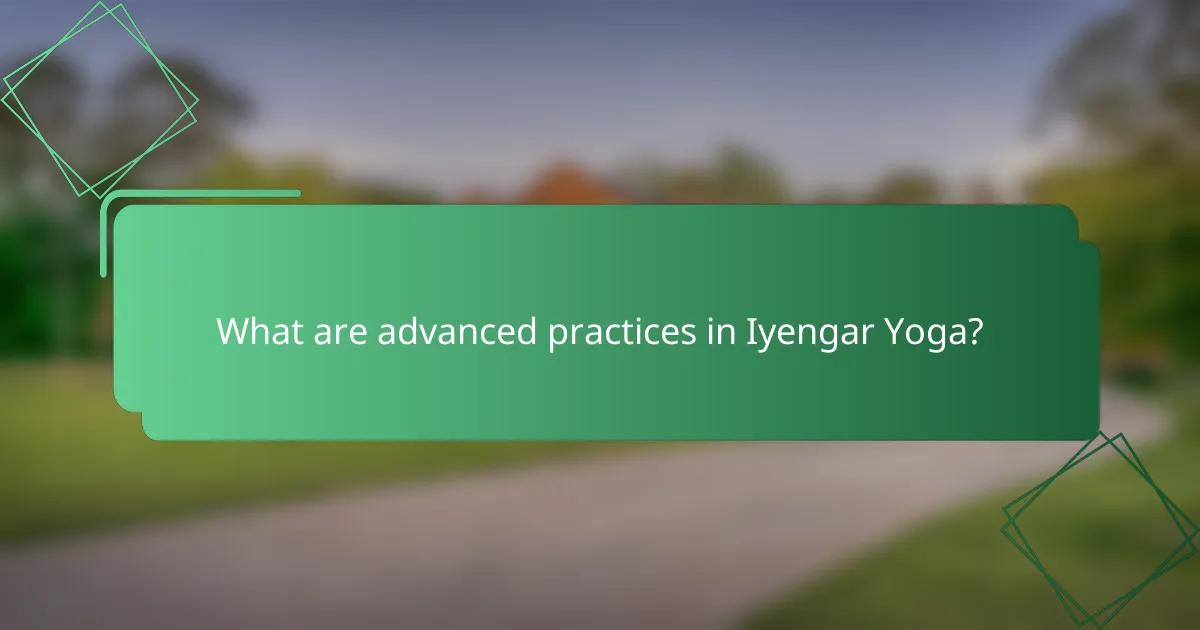
What are advanced practices in Iyengar Yoga?
Advanced practices in Iyengar Yoga involve a deeper exploration of poses, alignment, and precision. These practices require a solid foundation in basic postures and an understanding of the principles of alignment and body awareness.
Exploring advanced poses
Advanced poses in Iyengar Yoga include variations of foundational asanas that challenge strength, flexibility, and balance. Examples are arm balances, inversions, and deep backbends, which require precise alignment to avoid injury and maximize benefits.
When attempting advanced poses, it’s crucial to focus on alignment and engage the core muscles. Practitioners should use props, such as blocks and straps, to assist in achieving the correct form, especially when transitioning into more complex positions.
Common pitfalls include rushing into poses without adequate preparation or neglecting breath control. A gradual progression through intermediate poses can help build the necessary strength and stability for advanced practices.
Integrating meditation with Iyengar Yoga
Integrating meditation with Iyengar Yoga enhances mindfulness and body awareness during practice. This combination allows practitioners to focus on their breath and align their mental state with physical movements, fostering a deeper connection to the practice.
To effectively combine meditation with Iyengar Yoga, start with a few minutes of seated meditation before transitioning into asanas. During practice, maintain a meditative focus by observing sensations and thoughts without judgment, which can improve overall performance and enjoyment.
Practitioners should avoid distractions and create a calm environment to enhance their meditation experience. Regular integration of these practices can lead to improved concentration and a more profound understanding of both the body and mind.






